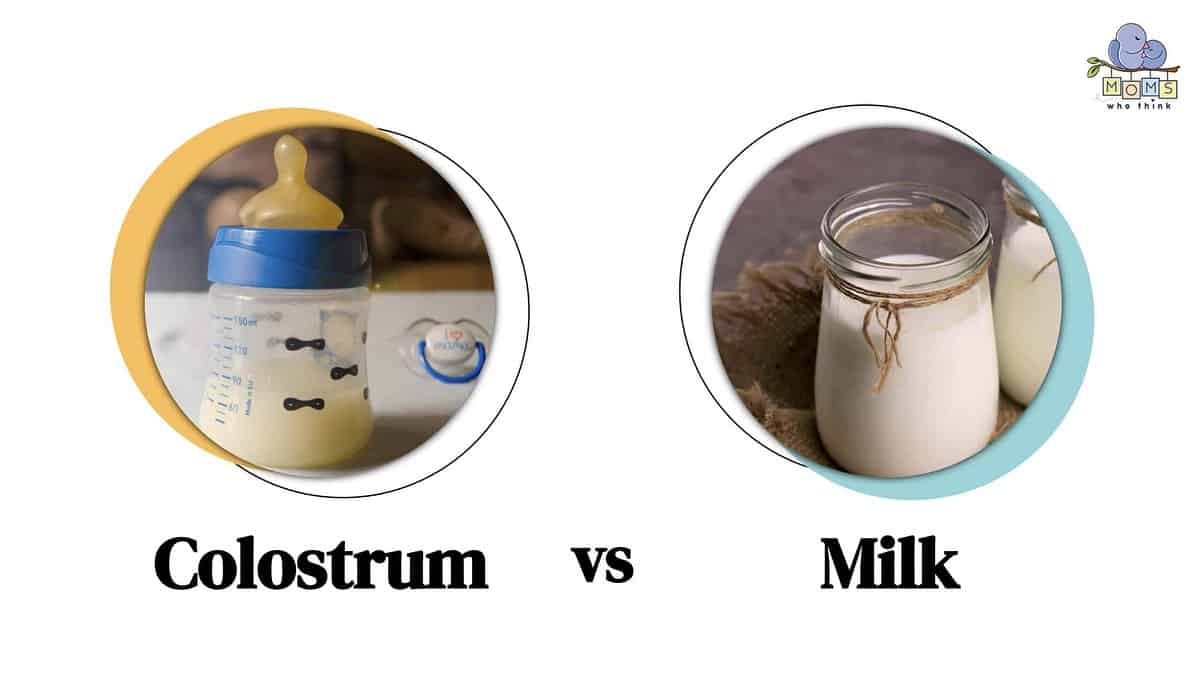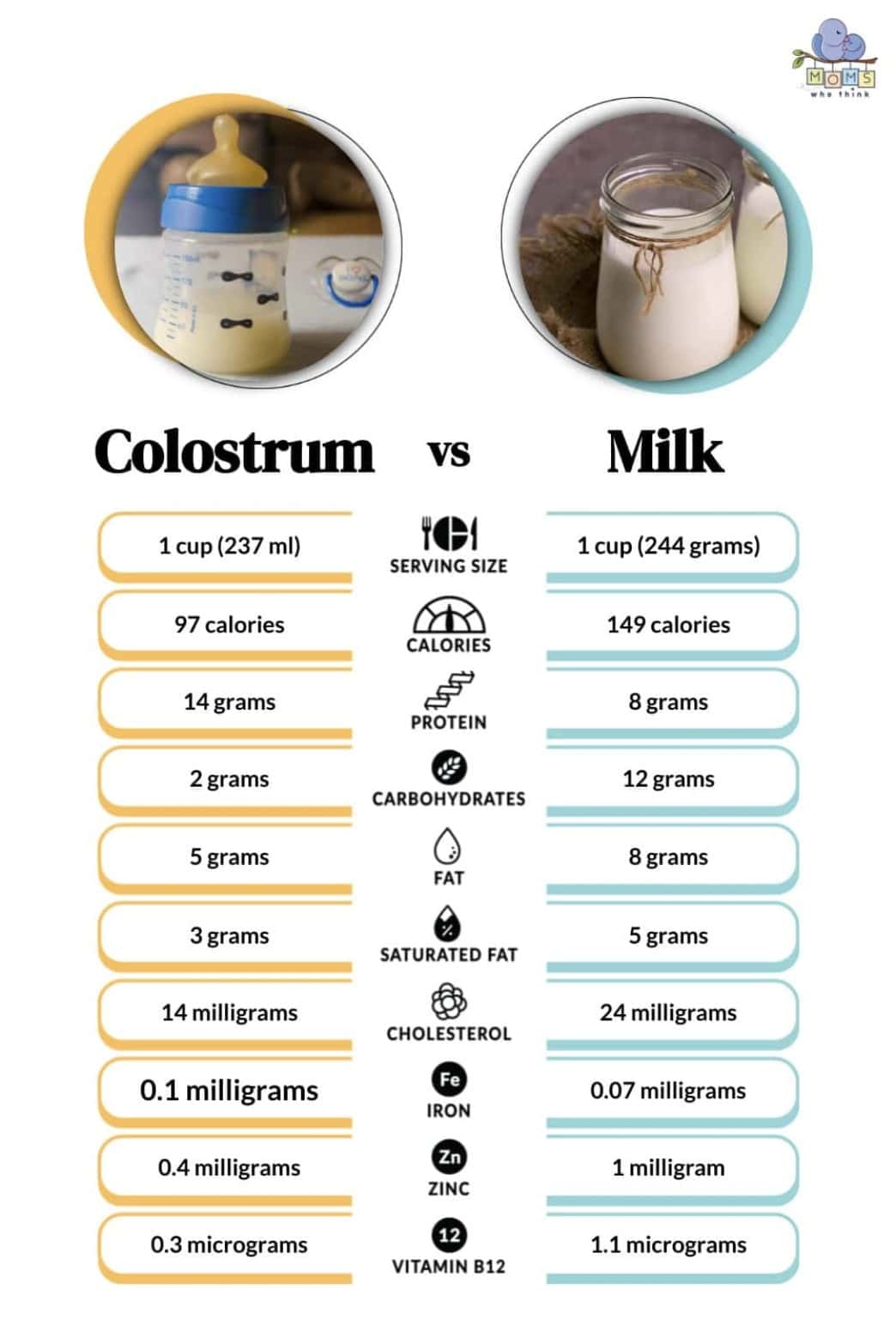At the very beginning of a parent’s nursing journey, there may be some questions about the differences between colostrum vs. milk. While both are produced in the early phases of milk production, colostrum is the first stage of milk. It is densely packed with nutrients and more yellow in color. Colostrum becomes milk a few days into the nursing process. Milk has a higher sugar content, less protein, more calories, and a creamier, less yellow coloration overall. So, if we take a look at color differences, nutritional content, and individual stages of milk production, there are lots of differentiators between colostrum vs. milk.
In this post, we’ll get into the details of how colostrum and mature milk are made. You’ll learn about how their nutritional makeup is integral to a baby’s first few nursing days. After all, there’s very much a biological reason that the body creates colostrum first before transitioning the flow into milk. Learn more about the health benefits of colostrum vs. milk. Once you’re done reading this post, you’ll know, without any doubt, the major and important differences. Let’s get into it!

Colostrum vs. Milk: What Is The Difference?
When comparing colostrum and milk, here's the easiest way to think about it: colostrum is the earliest stage of milk. Colostrum begins as the pregnancy ends and through the first few (typically 4) days of nursing. Then the milk comes in, first in a transitional form, then in its mature form. This mature form of milk is what the body produces until a baby is at the end of its nursing period. Colostrum and mature milk differ in nutritional makeup, maturity, and coloration. Now, we'll get into more of the details.
What Is Colostrum?
Colostrum is what is first produced once the baby is born. It is typically yellow in color, thicker than mature milk in consistency, and very dense in nutrients the baby needs. This golden, yellow coloration comes from the presence of the carotenoid pigment. Some colostrum is more white or transparent, and trace amounts of blood are also not uncommon. Some of the major nutrients found in colostrum include hemoglobin full of antibodies, and antioxidants. It's also packed with protein, and low in sugar, fat, and calories. Colostrum begins to shift towards mature milk after around 4 days (via Cleveland Clinic).

©Tolikoff Photography/Shutterstock.com
Origin Of Colostrum And Historical Facts
Colostrum has been produced since the origins of human pregnancies. However, its historical relationship to medicine is an interesting one. Early on, people likely didn't track the major differences between the shift from colostrum to mature milk. They didn't really have the tools for research of that kind. According to the Colostrum Research Organization, the use of colostrum for medicinal purposes has existed in Ayurvedic Indian culture since cows were first domesticated.
Early doctors were able to identify higher levels of antibodies in this early stage of milk production. These principles were applied in the creation of baby food to help immunize babies against diseases that could affect both cows and humans. The physician Albert Sabin, creator of the polio vaccine, used cow colostrum to isolate the first anti-polio antibodies. Sabin advocated for the use of colostrum in further medical research. And, throughout the years, the use of these nutrient-dense kinds of milk has been used in the treatment of immunodeficiencies, immunizations, and gastrointestinal diseases. Colostrum has always been integral to the health of nursing infants. It's simply incredible the ways it has been applied In the greater scheme of modern medicine.
What Is Milk?
Milk is a matured version of colostrum. It is a great source of continued nutrition for a newborn baby. Mil is chock full of proteins, sugars, and fats that are easily digested and absorbed by a new baby. Matured milk contains two types of proteins including whey and casein, as well as immune-supporting vitamins (via American Pregnancy Association). These attributes not only positively impact the baby, but can be great for the breastfeeding parent as well. Continuing to nurse into the first year of a baby's life can help the parent to heal after birth. It also encourages infant bonding and burns close to 600 calories while nursing is actively happening (via Women's Health).

©narikan/Shutterstock.com
Origin Of Milk
While we know where milk comes from, and what stage it's at compared to colostrum, let's take a look at its history. The practice of breastfeeding babies has, presumably, been around since the earliest of human pregnancies. However, the oldest written traces of the practice date to around 3000 B.C.
Through different ancient societies, “wet nursing” where another woman would provide the milk for a baby, was very popular. This had much more to do with the hierarchical roles of the society than any consideration of parental bonding with the child. “Wet nursing” continued throughout the second century A.D.
Like colostrum, mature milk was considered by Greek scholars as a potential medicinal avenue. As people learned more about colostrum, and the benefits of the milk already being produced by new mothers, attitudes shifted around breastfeeding one's own child (Gynecology and Obstetrics Medical Project). Eventually, bottle feeding was introduced, and other milk options like formula, or animal milk, were introduced into the breastfeeding culture.
Nutritional Comparison
As we've discussed, the nutritional makeup of colostrum vs. milk is one of the more important differentiators between the two. As you can see from this handy chart below, a cup of colostrum compared to a cup of milk differs in calorie count, grams of protein, and vitamin/mineral ratios. Colostrum is lower in carbohydrates, fat, and sugar content, and higher in protein and iron content than milk. Milk, on the other hand, has more fat, sugar, and cholesterol, all things that the new baby needs as it continues its development.

Colostrum vs. Milk: Are They The Same Thing?
While colostrum is an early, nutrient-dense stage of mature milk, the two are still quite different. They can be compared in terms of their calorie, fat, sugar, carbohydrate, and protein content. Colostrum differs in the nutrient and mineral components, which in turn affect the coloration of the substance. Typical colostrum is yellow/golden in color. Howwever, it can also be more white, transparent, or tinged red, depending on the situation. Milk is less thick than colostrum, and creamier in coloration.
Possible Alternatives To Colostrum vs. Milk
Most medical organizations recommend breast milk as the healthiest way to help an infant grow. However, there are always going to be situations in which that is not an option. If possible, feeding an infant with breastmilk for the first 6 months before switching, can be one of the better options. Feeding with a bottle is also an option if latching or inflammation is the issue with typical breastfeeding. Pumping milk allows for more flexibility in how and when you feed your baby. There are also resources for breast milk donation, which in principle is similar to wet nursing. Be sure you know your source really well because their health can very much impact the health of the milk you're receiving.
There are still milk alternatives available if breastmilk is not the best fit for your situation. Baby formula can provide a good nutritional alternative to traditional breast milk. Be sure to seek out high-quality baby formula, if you are able. The formula contains a base of cow milk or soy-based proteins. There are also hydrolyzed formulas which makes the formula easier to digest. This last option may be best for infants with suspected food allergies. Be sure to do lots of research in regard to picking your formula. Keep in mind that the formulas available in the store are commercially approved and studied for health risks. These risks cannot be predicted for homemade formula trials. When in doubt, consult a medical professional to get the best ideas for milk alternatives to breastfeeding (via Web MD).

©New Africa/Shutterstock.com
The image featured at the top of this post is ©narikan/Shutterstock.com.
